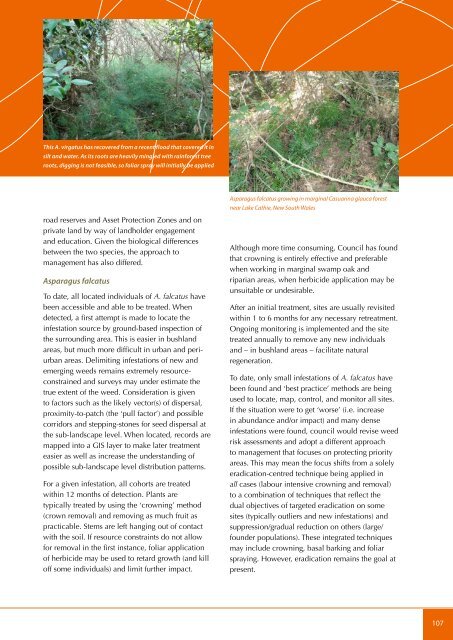Asparagus weeds - Weeds Australia
Asparagus weeds - Weeds Australia
Asparagus weeds - Weeds Australia
- No tags were found...
Create successful ePaper yourself
Turn your PDF publications into a flip-book with our unique Google optimized e-Paper software.
This A. virgatus has recovered from a recent flood that covered it insilt and water. As its roots are heavily mingled with rainforest treeroots, digging is not feasible, so foliar spray will initially be appliedroad reserves and Asset Protection Zones and onprivate land by way of landholder engagementand education. Given the biological differencesbetween the two species, the approach tomanagement has also differed.<strong>Asparagus</strong> falcatusTo date, all located individuals of A. falcatus havebeen accessible and able to be treated. Whendetected, a first attempt is made to locate theinfestation source by ground-based inspection ofthe surrounding area. This is easier in bushlandareas, but much more difficult in urban and periurbanareas. Delimiting infestations of new andemerging <strong>weeds</strong> remains extremely resourceconstrainedand surveys may under estimate thetrue extent of the weed. Consideration is givento factors such as the likely vector(s) of dispersal,proximity-to-patch (the ‘pull factor’) and possiblecorridors and stepping-stones for seed dispersal atthe sub-landscape level. When located, records aremapped into a GIS layer to make later treatmenteasier as well as increase the understanding ofpossible sub-landscape level distribution patterns.For a given infestation, all cohorts are treatedwithin 12 months of detection. Plants aretypically treated by using the ‘crowning’ method(crown removal) and removing as much fruit aspracticable. Stems are left hanging out of contactwith the soil. If resource constraints do not allowfor removal in the first instance, foliar applicationof herbicide may be used to retard growth (and killoff some individuals) and limit further impact.<strong>Asparagus</strong> falcatus growing in marginal Casuarina glauca forestnear Lake Cathie, New South WalesAlthough more time consuming, Council has foundthat crowning is entirely effective and preferablewhen working in marginal swamp oak andriparian areas, when herbicide application may beunsuitable or undesirable.After an initial treatment, sites are usually revisitedwithin 1 to 6 months for any necessary retreatment.Ongoing monitoring is implemented and the sitetreated annually to remove any new individualsand – in bushland areas – facilitate naturalregeneration.To date, only small infestations of A. falcatus havebeen found and ‘best practice’ methods are beingused to locate, map, control, and monitor all sites.If the situation were to get ‘worse’ (i.e. increasein abundance and/or impact) and many denseinfestations were found, council would revise weedrisk assessments and adopt a different approachto management that focuses on protecting priorityareas. This may mean the focus shifts from a solelyeradication-centred technique being applied inall cases (labour intensive crowning and removal)to a combination of techniques that reflect thedual objectives of targeted eradication on somesites (typically outliers and new infestations) andsuppression/gradual reduction on others (large/founder populations). These integrated techniquesmay include crowning, basal barking and foliarspraying. However, eradication remains the goal atpresent.107
















